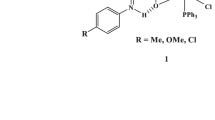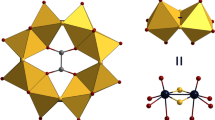Abstract
The synthesis and characterization of bromo- and iodo complexes of Pd(II) containing tridentate anionic Schiff bases, derived from the ring-opening of 2-R-2-(2-pyridyl)benzothiazoline precursors (R = H, 1; R = Me, 2; R = C6H5, 3; R = C5H4N, 4) is described. The [Pd(Ln)X] complexes [for X = Br: n = 1 (1a), n = 2 (2a), n = 3 (3a), and n = 4, (4a); for X = I: n = 1 (1b), n = 2 (2b), n = 3 (3b), and n = 4 (4b)] were characterized in solution and in solid state by NMR and IR spectroscopy and by elemental analyses. In all complexes, the corresponding anionic Schiff ligand {Ln}− displayed a κ2NκS-tridentate coordination mode. X-ray diffraction studies of [Pd(L3)Br] (3a), [Pd(L3)I] (3b), [Pd(L4)Br] (4a), and [Pd(L4)I] (4b) complexes showed the formation of two five-membered chelate rings, with a distorted square planar geometry around the Pd(II) cation. Crystal structures of 3a, 3b, 4a, and 4b are stabilized by non-classical C–H···π, C–H···S, and C–H···X hydrogen bonding. The Hirshfeld surface analysis showed that the H···H contacts are predominant, and the C–H···S or C–H···π interactions were the major contributions in the stacking of the molecular complexes.








Similar content being viewed by others
Data availability
No datasets were generated or analysed during the current study.
References
Lynn MA, Carlson LJ, Hwangbo H, Tanski JM, Tyler LA (2012) Structural influences on the oxidation of a series of 2-benzothiazoline analogs. J Mol Struct 1011:81–93. https://doi.org/10.1016/j.molstruc.2011.12.001
Mitra S, Chakabrorty A, Mishra S, Majee A, Hajra A (2014) Copper(I)-catalyzed oxidative coupling between 2-aminobenzothiazole and terminal alkyne: formation of benzothiazine. Org Lett 16:5652–5655. https://doi.org/10.1021/ol502729c
Carlson LJ, Welby J, Zebrowsky KA, Wilk MM, Giroux R, Ciancio N, Tanski JM, Bradley A, Tyler LA (2011) Spectroscopic differences between heterocyclic benzothiazoline, -thiazole and imine containing ligands and comparison of the Co and Cu pyridine benzothiazole and imine complexes. Inorg Chim Acta 365:159–166. https://doi.org/10.1016/j.ica.2010.09.002
Anacona JR, Marquez VE, Jimenez Y (2009) Synthesis and characterization of manganese(II), nickel(II), copper(II) and zinc(II) Schiff-base complexes derived from 1,10- phenanthroline-2,9-dicarboxaldehyde and 2-mercaptoethylamine. J Coord Chem 62:1172–1179. https://doi.org/10.1080/00958970802382768
Das UK, Daifuku SL, Gorelsky SI, Korobkov I, Neidig ML (2016) Mononuclear, dinuclear, and trinuclear iron complexes featuring a new monoanionic SNS thiolate ligand. Inorg Chem 55:987–997. https://doi.org/10.1021/acs.inorgchem.5b02833
Kawamoto T, Nishiwaki M, Tsunekawa Y, Nozaki K, Konno T (2008) Synthesis and characterization of luminescent zinc (II) and cadmium (II) complexes with N, S-chelating Schiff base ligands. Inorg Chem 47:3095–3104. https://doi.org/10.1021/ic7020758
Xie Z-L, Pennington DL, Boucher DG, Lo J, Rose MJ (2018) Effects of thiolate ligation in monoiron hydrogenase (Hmd): stability of the {Fe(CO)2}2+ Core with NNS ligands. Inorg Chem 57:10028–10039. https://doi.org/10.1021/ic7020758
Kovala-Demertzi D, Domopoulou A, Demertzis M (1994) Coordinating properties of 2-acetylpyridine thiosemicarbazone palladium(II) complexes with neutral and deprotonated ligand. X-ray structure of bromo(2-acetylpyridine thiosemicarbazonato) palladium(II). Polyhedron 13:1917–1925. https://doi.org/10.1016/0277-5387(94)80015-4
Katti KV, Singh PR, Barnes CL (1993) Transition -metal chemistry of main-group hydrazides. Part 2. A new oxirne thiosemicarbazide framework as a novel SN multifunctional tripodal ligand for palladium(ll): synthetic and x-ray crystal structural investigations. J Chem Soc Dalton Trans. https://doi.org/10.1039/DT9930002153
Kovala-Demertzi D, Domopoulou A, Demertzis MA (1996) Structures and spectral properties of palladium(II) complexes of 2-acetylpyridine N(4)-dimethylthiosemicarbazone. Polyhedron 15:2587–2596. https://doi.org/10.1016/0277-5387(95)00538-2
Kovala-Demertzi D, Demertzis MA, Millera JR, Papadopoulou C, Dodorou C, Filousis G (2001) Platinum(II) complexes with 2-acetyl pyridine thiosemicarbazone Synthesis, crystal structure, spectral properties, antimicrobial and antitumour activity. J Inorg Biochem 86:555–563. https://doi.org/10.1016/S0162-0134(01)00224-0
Kovala-Demertzi D, Yadav PN, Demertzis MA, Coluccia M (2000) Synthesis, crystal structure, spectral properties and cytotoxic activity of platinum(II) complexes of 2-acetyl pyridine and pyridine-2-carbaldehyde N(4)-ethyl-thiosemicarbazones. J Inorg Biochem 78:347–354. https://doi.org/10.1016/S0162-0134(00)00063-5
Alvarez-Hernández JA, Andrade-López N, Alvarado-Rodríguez JG, Vásquez-Pérez JM, Cruz-Borbolla J, Jancik V (2017) Synthesis and structural characterization of 10 Group metal complexes with anionic tridentate S, N, N donor Schiff bases derived from pyridylbenzothiazolines. Polyhedron 135:169–179. https://doi.org/10.1016/j.poly.2017.07.004
Bacchi A, Carcelli M, Pelizzi C, Pelizzi G, Pelagatti P, Ugolotti S (2002) Potentially tridentate ligands in the synthesis of methyl- and acetylpalladium(II) complexes. Eur J Inorg Chem 2002(8):2179–2187
Abellán-López A, Chicote-Olalla MT, Bautista-Cerezo D (2012) Cis-Diiodido(N, N, N’, N’-tetramethyl-ethylenediamine-κ2N, N)palladium(II). Acta Cryst E 68:m1129. https://doi.org/10.1107/S1600536812033004
Bruker AXS Inc. SAINT and SADABS, Bruker AXS Inc., Madison, Wisconsin (2007).
Krause L, Herbst-Irmer R, Sheldrick G, Stalke D (2015) Comparison of silver and molybdenum microfocus X-ray sources for single-crystal structure determination. J Appl Cryst 48:3–10. https://doi.org/10.1107/S1600576714022985
Dolomanov OV, Bourhis LJ, Gildea RJ, Howard JAK, Puschmann H (2009) OLEX2: a complete structure solution, refinement and analysis program. J Appl Cryst 42:339–341. https://doi.org/10.1107/S0021889808042726
Sheldrick GM (2015) SHELXT–Integrated space-group and crystal-structure determination Acta. CrystA. 71(3–8): 2832–2838. https://doi.org/10.1107/S2053273314026370
Cordero B, Gómez V, Platero-Prats AE, Revés M, Echeverría J, Cremades E, Barragán F, Alvarez S (2008) Covalent radii revisited. Dalton Trans 21:2832–2838. https://doi.org/10.1039/B801115
Spackman MA, Jayatilaka D (2009) Hirshfeld surface analysis. CrystEngComm 11:19–32. https://doi.org/10.1039/B818330A
Spackman PR, Turner MJ, McKinnon JJ, Wolff SK, Grimwood DJ, Jayatilaka D, Spackman MA (2021) CrystalExplorer: a program for Hirshfeld surface analysis, visualization and quantitative analysis of molecular crystals. J Appl Cryst 54:1006–1011. https://doi.org/10.1107/S1600576721002910
Szell PMJ, Cavallo G, Terraneo G, Metrangolo P, Gabidullin B, Bryce DL (2018) Comparing the halogen bond to the hydrogen bond by solid-state NMR: anion coordinated dimers from 2- and 3-Iodoethynylpyridine Salts. Chem Eur J 24:11364–11376. https://doi.org/10.1002/chem.201801279
Kuyuldar S, Burda C, Connick WB (2019) Halide exchange studies of novel Pd(II) NNN-pincer complexes. RSC Adv 9:25703–25711. https://doi.org/10.1039/C9RA05423E
Flemming JP, Pilon MC, Borbulevitch OYa, Antipin MYu, Grushing VV, (1998) The trans influence of F, CI, Br and I ligands in a series of square-planar Pd(II) complexes. Relative affinities of halide anions for the metal centre in trans-[(Ph3P)2Pd(Ph)X]. Inorg Chim Acta 280:87–98. https://doi.org/10.1016/S0020-1693(98)00055-3
Behnia A, Fard MA, Blacquiere JM, Puddephatt RJ (2018) Mild and selective Pd–Ar protonolysis and C-H activation promoted by a ligand aryloxide group. Dalton Trans 47:3538–3548. https://doi.org/10.1039/C8DT00437D
Alvarez-Hernández JA, Andrade-López N, Alvarado-Rodríguez JG, González-Montiel S, Zarate-Hernández LA, Cruz-Borbolla J (2022) Synthesis and characterization of organopalladium(II) complexes of N, N, S–tridentate sulfur-containing Schiff bases derived from 2-(2-pyridyl) benzothiazolines. Polyhedron 214:115635. https://doi.org/10.1016/j.poly.2021.115635
Batsanov SS (2001) Van der Waals radii of elements. Inorg Mater 37:871–885. https://doi.org/10.1023/A:1011625728803
Spackman MA, Byrom PG (1997) A novel definition of a molecule in a crystal. Chem Phys Lett 267:215–220. https://doi.org/10.1016/S0009-2614(97)00100-0
Matta CF, Hernández-Trujillo J, Tang TH, Bader RF (2003) Hydrogen–hydrogen bonding: a stabilizing interaction in molecules and crystals. Chem Eur J 9(9):1940–1951
Mackenzie CF, Spackman PR, Jayatilaka D, Spackman MA (2017) CrystalExplorer model energies and energy frame-works: extension to metal coordination compounds, organic salts, solvates and open-shell systems. IUCrJ 4:575–587. https://doi.org/10.1107/S205225251700848X
Acknowledgements
JAAH and OMG be grateful to CONAHCYT México for their scholarships. This research was supported by project UAEH/DI/ICBI/Quí-12.
Author information
Authors and Affiliations
Contributions
JAA-H contributed to the methodology and supporting, NA-L contributed to conceptualization, methodology, formal analysis, writing- original draft, writing-review and editing, supervision, resources, JGA-R contributed to formal analysis, writing-review & editing resources, OM-G contributed to the methodology and supporting, GS-C was involved in supporting and formal analysis, DM-O was involved in the formal analysis and data curation. All authors reviewed the manuscript
Corresponding author
Ethics declarations
Conflict of interest
The authors declare no competing interests.
Additional information
Publisher's Note
Springer Nature remains neutral with regard to jurisdictional claims in published maps and institutional affiliations.
Supplementary Information
Below is the link to the electronic supplementary material.
11243_2024_580_MOESM1_ESM.docx
CCDC 2305457 (3a, 100 K), 2305455 (3a’, 300 K), 2305456 (3b, 100 K), 2305459 (3b', 300 K), 2305454 (4a, 100 K), and 2305458 (4b, 100 K) contains the supplementary crystallographic data. These data can be obtained free of charge via http://www.ccdc.cam.ac.uk/conts/retrieving.html, or from the Cambridge Crystallographic Data Centre, 12 Union Road, Cambridge CB2 1EZ, UK; fax: (+44) -336-033; or e-mail: deposit@ccdc.cam.ac.uk.
Supplementary file1 (DOCX 2942 kb)
Rights and permissions
Springer Nature or its licensor (e.g. a society or other partner) holds exclusive rights to this article under a publishing agreement with the author(s) or other rightsholder(s); author self-archiving of the accepted manuscript version of this article is solely governed by the terms of such publishing agreement and applicable law.
About this article
Cite this article
Alvarez-Hernández, JA., Andrade-López, N., Alvarado-Rodríguez, J.G. et al. Palladium(II) halide complexes of N,N,S-tridentate Schiff bases: synthesis, structural studies in solution and solid state, and analysis of Hirshfeld surfaces. Transit Met Chem (2024). https://doi.org/10.1007/s11243-024-00580-z
Received:
Accepted:
Published:
DOI: https://doi.org/10.1007/s11243-024-00580-z




